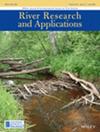山区溪流网络中的木桩:模式、生物地貌关联和人为影响
IF 1.9
4区 环境科学与生态学
Q4 ENVIRONMENTAL SCIENCES
引用次数: 0
摘要
木桩是河道内的伐木堆积物,在河流生态系统的生物物理过程中发挥着重要作用。在这项在西北太平洋内陆山区进行的研究中,我们利用流域尺度的清单,对木栓的频率、数量及其与一系列生物物理景观特征和人为影响的关系进行了全面分析。我们利用过程域的概念对这一分析进行了补充。我们发现,在约 10-30 平方公里的流域面积内,原木堵塞频率随流域面积的增加而增加,之后则随流域面积的减少而减少;而在 300 平方公里的流域面积内,平均堵塞量则随流域面积的增加而稳步增加。这些变量结合在一起,形成了大木头储存在木栓中的非线性下游模式,在流域面积约为 10-100 平方公里时达到顶峰。原木坝的特征与多个预测因子相关,这些预测因子被用作与大木头供应和再分布相关的生物地貌过程的代用指标:河岸侵蚀、滑坡、崩塌、河岸林中的木材供应以及木材运输。此外,还推断人为干扰对研究流域的原木坝形成过程有很大影响。一条铺设了防渗层的林道破坏了大木头供应的过程链,侵蚀破坏了坡脚,最终引发山体滑坡。木材采伐通过减少森林生物量来影响大木头的供应。总之,这些研究结果有助于加深对原木卡塞的理解:它们让我们深入了解了自然和人为因素相互作用的复杂过程,这些因素通过调节大木头的输入和再分布,形成了流域尺度的卡塞频率和数量模式。我们相信,我们的研究将有助于为河流管理和恢复实践提供信息。本文章由计算机程序翻译,如有差异,请以英文原文为准。
Logjams in a mountain stream network: Patterns, biogeomorphic associations, and anthropogenic impacts
Logjams, in‐channel accumulations of downed wood, play important roles governing biophysical processes in river ecosystems. In this study conducted in the mountainous inland Pacific Northwest, we leveraged a basin‐scale inventory to carry out a comprehensive analysis of logjam frequency, volume, and their associations with a suite of biophysical landscape characteristics and anthropogenic influences. We complemented this analysis with one that relies on the concept of process domains. We found that logjam frequency increased with drainage area up to ~10–30 km2 and declined thereafter, while the mean jam volume steadily increased downstream up to the area of >300 km2 . Combined, these variables yielded a nonlinear downstream pattern of large wood storage in jams, peaking at drainage areas of ~10–100 km2 . Logjam characteristics were associated with multiple predictors, used as proxies for biogeomorphic processes relevant for large wood supply and redistribution: bank erosion, landslides, avulsions, wood availability in riparian forest, and wood transport. Additionally, anthropogenic disturbances were inferred to strongly influence logjam‐forming processes in the study basin. A riprapped forest road disrupted a process chain responsible for large wood supply, wherein erosion undercuts slope toe, ultimately triggering landslides. Timber harvest influenced large wood supply by reducing forest biomass. Overall, these findings contribute to improved understanding of logjams: they provide insight into the complex suite of interacting natural and anthropogenic factors which, by regulating large wood inputs and redistribution, generate a basin‐scale pattern in jam frequency and volume. We believe that our study will be useful in informing river management and restoration practices.
求助全文
通过发布文献求助,成功后即可免费获取论文全文。
去求助
来源期刊

River Research and Applications
环境科学-环境科学
CiteScore
4.60
自引率
9.10%
发文量
158
审稿时长
6 months
期刊介绍:
River Research and Applications , previously published as Regulated Rivers: Research and Management (1987-2001), is an international journal dedicated to the promotion of basic and applied scientific research on rivers. The journal publishes original scientific and technical papers on biological, ecological, geomorphological, hydrological, engineering and geographical aspects related to rivers in both the developed and developing world. Papers showing how basic studies and new science can be of use in applied problems associated with river management, regulation and restoration are encouraged as is interdisciplinary research concerned directly or indirectly with river management problems.
 求助内容:
求助内容: 应助结果提醒方式:
应助结果提醒方式:


